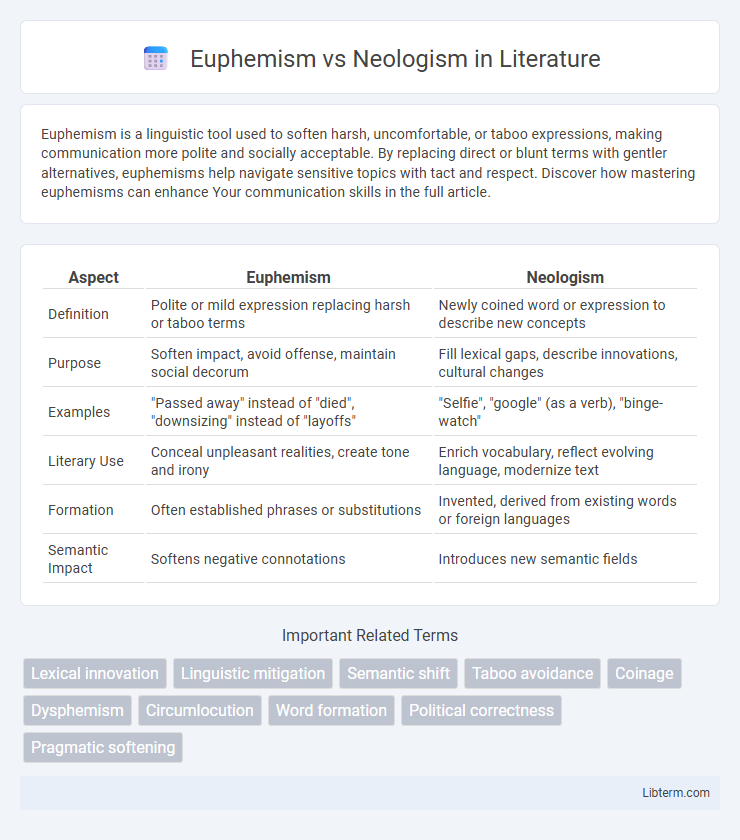Euphemism is a linguistic tool used to soften harsh, uncomfortable, or taboo expressions, making communication more polite and socially acceptable. By replacing direct or blunt terms with gentler alternatives, euphemisms help navigate sensitive topics with tact and respect. Discover how mastering euphemisms can enhance Your communication skills in the full article.
Table of Comparison
| Aspect | Euphemism | Neologism |
|---|---|---|
| Definition | Polite or mild expression replacing harsh or taboo terms | Newly coined word or expression to describe new concepts |
| Purpose | Soften impact, avoid offense, maintain social decorum | Fill lexical gaps, describe innovations, cultural changes |
| Examples | "Passed away" instead of "died", "downsizing" instead of "layoffs" | "Selfie", "google" (as a verb), "binge-watch" |
| Literary Use | Conceal unpleasant realities, create tone and irony | Enrich vocabulary, reflect evolving language, modernize text |
| Formation | Often established phrases or substitutions | Invented, derived from existing words or foreign languages |
| Semantic Impact | Softens negative connotations | Introduces new semantic fields |
Introduction to Euphemism and Neologism
Euphemism involves substituting mild or indirect terms for harsh, blunt, or offensive expressions to soften communication and avoid social discomfort. Neologism refers to the creation of entirely new words or phrases that emerge to describe novel concepts, phenomena, or cultural trends. Both linguistic phenomena reflect the dynamic nature of language, adapting to societal changes and communicative needs.
Defining Euphemisms: Purpose and Examples
Euphemisms are mild or indirect words or expressions used to replace terms considered harsh, blunt, or offensive, aiming to soften the impact of sensitive subjects. Their purpose is to facilitate polite conversation and reduce discomfort when discussing topics like death (e.g., "passed away" instead of "died"), bodily functions ("bathroom" instead of "toilet"), or layoffs ("downsizing" instead of "firing"). Common examples of euphemisms include "senior citizen" for elderly people and "let go" for job termination, highlighting their role in social and cultural communication.
What Is a Neologism? Understanding New Words
A neologism is a newly coined word or expression that often emerges to describe novel concepts, technologies, or cultural phenomena. These fresh terms rapidly enter everyday language, filling gaps that existing vocabulary cannot adequately address. Tracking neologisms provides insight into language evolution and societal changes.
Key Differences Between Euphemism and Neologism
Euphemism involves substituting a mild or indirect word or expression for one considered harsh or blunt, commonly used to soften sensitive topics like death or bodily functions. Neologism refers to the creation of entirely new words or expressions to describe novel concepts, inventions, or cultural phenomena, often driven by technological advancements or social changes. The key difference lies in euphemism modifying existing language to reduce offense or discomfort, while neologism expands the vocabulary by introducing original terms.
Historical Evolution of Euphemisms
Euphemisms have evolved historically as linguistic tools to soften or obscure harsh realities, reflecting societal attitudes and taboos across cultures and eras. Originating from Ancient Greek, where "eu-" means good and "-pheme" means speech, euphemisms transformed expressions of death, bodily functions, and social hierarchies into more palatable phrases. Over centuries, this adaptive language mechanism has both preserved social harmony and revealed cultural shifts through its ongoing lexical refinements.
The Birth and Adoption of Neologisms
Neologisms emerge as innovative linguistic creations filling lexical gaps or addressing new cultural phenomena, often originating from technological advances, social trends, or scientific discoveries. Their adoption depends on factors like ease of use, relevance, and media exposure, fostering gradual integration into everyday language and dictionaries. Unlike euphemisms, which soften or obscure meanings, neologisms introduce entirely new terms that reshape communication and conceptual frameworks.
Euphemism in Social and Cultural Context
Euphemism serves as a linguistic tool that softens or disguises harsh or offensive concepts, facilitating sensitive communication within various social and cultural contexts. It reflects societal norms and taboos by substituting terms related to death, bodily functions, and social stigmas with less direct phrases, thereby maintaining politeness and social harmony. The use of euphemisms varies across cultures, revealing underlying values and collective attitudes toward topics often considered uncomfortable or controversial.
Neologism in Modern Communication and Media
Neologisms drive innovation in modern communication and media by introducing new words that capture emerging concepts, technologies, and cultural shifts. Social media platforms and digital content rapidly spread neologisms, influencing language evolution and reflecting current societal trends. These newly coined terms enhance expressiveness and enable precise communication in fast-changing contexts like technology, entertainment, and internet culture.
Impacts on Language and Society
Euphemisms soften potentially offensive or uncomfortable concepts, influencing social communication by promoting politeness and reducing conflict, which can obscure clarity or delay addressing critical issues. Neologisms introduce new words or expressions, reflecting cultural shifts and technological advancements, thereby enriching vocabulary and enabling more precise or contemporary communication. Both phenomena shape language evolution, reflecting societal values and impacting how communities perceive and discuss emerging or sensitive topics.
Conclusion: Embracing Change in Language
Euphemism softens expressions to navigate social sensitivities, while neologism injects innovation by introducing entirely new words or meanings. Both play crucial roles in reflecting cultural shifts and evolving communication needs. Embracing these linguistic changes ensures language remains dynamic, relevant, and capable of capturing emerging concepts and societal values.
Euphemism Infographic

 libterm.com
libterm.com